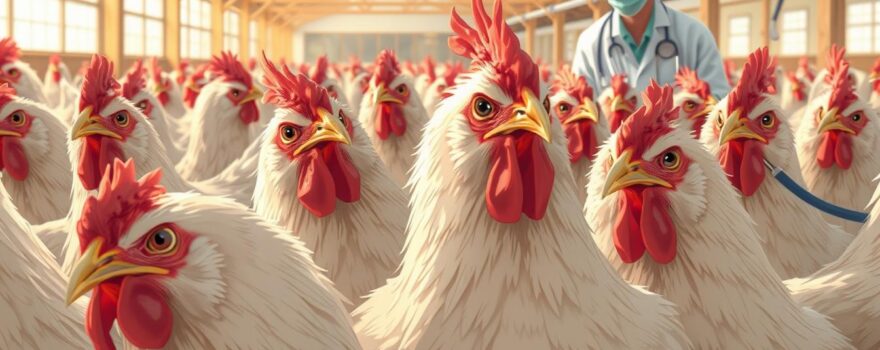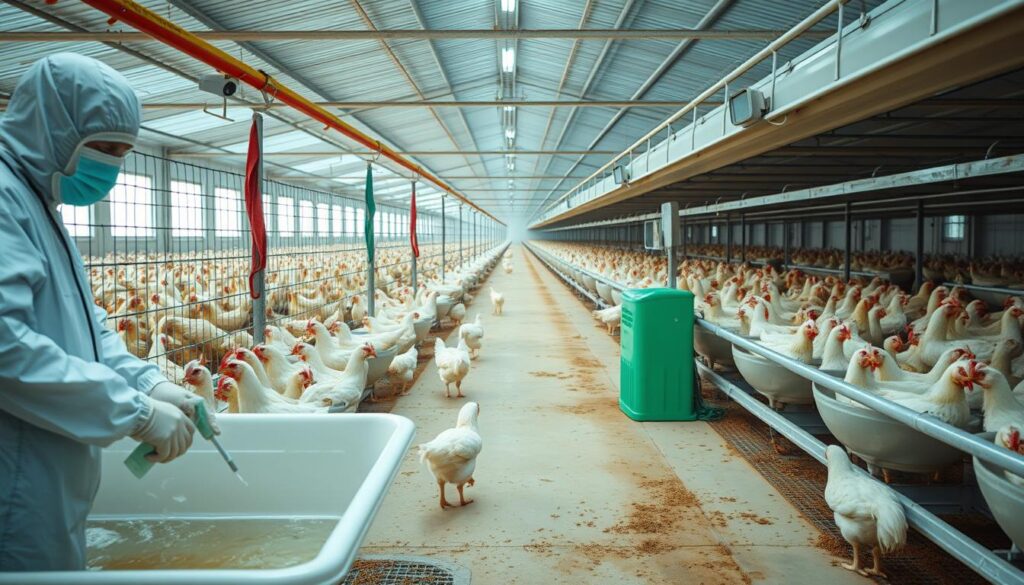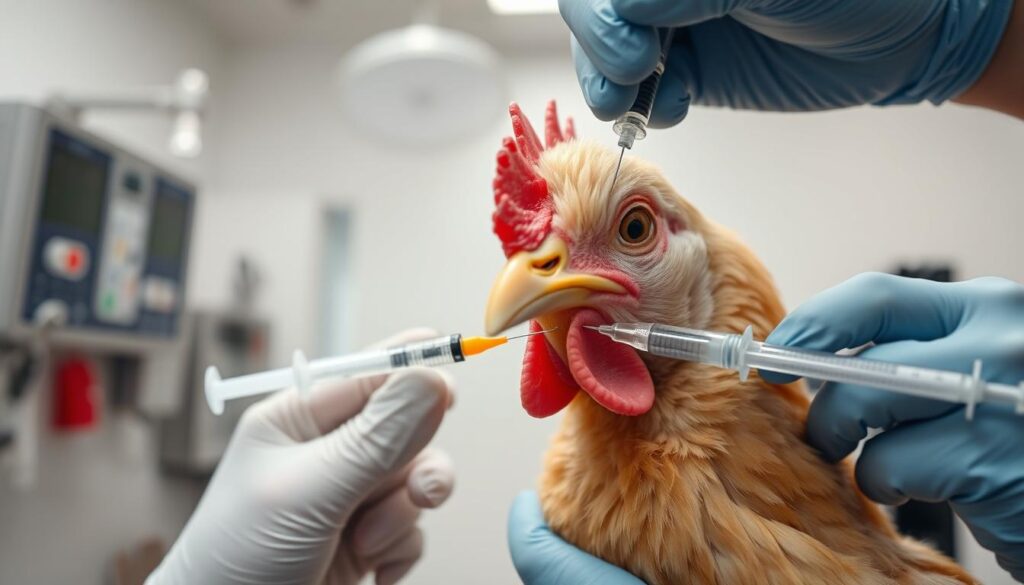
Respiratory diseases are a big problem for broiler chicken farmers. They can hurt the health and work of the chickens. Viral infections like avian influenza and Newcastle disease are very contagious. Bacterial infections like Mycoplasma gallisepticum are also common.
We will talk about how to find, treat, and stop these diseases. This will help farmers keep their chickens healthy and strong.
Key Takeaways
- Respiratory diseases are a major challenge for broiler chicken farmers, impacting flock health and productivity.
- Common respiratory pathogens include avian influenza, infectious bronchitis, Newcastle disease, and Mycoplasma gallisepticum.
- Proper diagnosis, using a combination of clinical signs, laboratory testing, and diagnostic tools, is crucial for effective management.
- Comprehensive disease management strategies, including biosecurity, air quality control, and vaccination programs, are essential for preventing and controlling respiratory diseases.
- Antibiotic treatment may be necessary for bacterial respiratory infections, but it should be used judiciously to minimize the risk of antimicrobial resistance.
Introduction to Respiratory Diseases in Broiler Chickens
Respiratory diseases are a big problem in broiler chicken farms. They hurt the health, growth, and profits of the chickens. It’s important to know about these diseases to manage them well.
Broiler chickens get sick easily because of many respiratory diseases. These sicknesses can make the chickens eat less, grow slower, and die sooner. This hurts the farm’s success and profits.
These diseases come from viruses, bacteria, and fungi. Some common ones are:
- Avian Influenza
- Infectious Bronchitis
- Newcastle Disease
- Mycoplasma Gallisepticum
How bad these diseases are can change. It depends on things like the environment, how the chickens are kept, and their health.
“Respiratory diseases are a major concern in the broiler chicken industry, as they can have a significant impact on the overall productivity and profitability of the farm.”
To fight these diseases, we need a plan that includes finding and treating the sickness. We also need to prevent it from coming back. This keeps the chickens healthy, helps them grow well, and keeps the farm running smoothly.
Common Respiratory Diseases in Broiler Chickens: Diagnosis and Management
Respiratory infections are a big problem for broiler chicken farmers. Avian influenza and infectious bronchitis are two common diseases. Knowing how to diagnose and manage them is key to keeping chickens healthy and productive.
Avian Influenza
Avian influenza, or bird flu, is a viral disease that mainly hits chickens’ respiratory systems. The virus can be very contagious. It’s important to spot it early to stop it from spreading and causing big losses.
Symptoms include coughing, sneezing, and nasal discharge. Chickens may also eat less. Tests like PCR and serological assays help confirm the virus and start control actions.
Infectious Bronchitis
Infectious bronchitis is another common disease in broiler chickens. It’s caused by the infectious bronchitis virus (IBV). This virus affects the respiratory system and other areas like the urinary and reproductive systems.
Signs include gasping, coughing, sneezing, and less egg production in layers. To diagnose it, doctors look at symptoms, isolate the virus, and use molecular tests. Vaccination and good biosecurity are key to controlling the disease.
Handling respiratory diseases like avian influenza and infectious bronchitis needs a detailed plan. This includes quick detection, the right treatments, and strong biosecurity. By following best practices, farmers can reduce the effects of these diseases on their flocks.
Newcastle Disease: A Highly Contagious Viral Infection
Newcastle disease is a severe and highly contagious viral infection. It can have devastating consequences for broiler chicken flocks. The Newcastle disease virus (NDV) is the cause and belongs to the Paramyxoviridae family.
The virus attacks the respiratory system, causing symptoms like coughing and sneezing. In severe cases, it can affect the nervous system, leading to tremors and paralysis. Mortality rates vary based on the virus’s virulence and the flock’s susceptibility.
Newcastle disease spreads through direct contact, contaminated equipment, and airborne particles. Proper biosecurity measures are key to preventing and controlling outbreaks. The virus can persist in the environment, making new farms vulnerable.
Effective biosecurity strategies for managing Newcastle disease include:
- Strict control of personnel and vehicle movements onto the farm
- Thorough cleaning and disinfection of all equipment and facilities
- Proper disposal of dead birds and manure
- Vaccination of the flock to build immunity
- Vigilant monitoring and early detection of any signs of illness
By implementing comprehensive biosecurity measures, poultry producers can prevent devastating Newcastle disease outbreaks. This protects the health and productivity of their broiler chicken flocks.
| Key Characteristics of Newcastle Disease | Impact on Broiler Chickens |
|---|---|
| Highly contagious viral infection | Severe respiratory symptoms and high mortality rates |
| Caused by the Newcastle disease virus (NDV) | Significant economic losses for poultry farmers |
| Spreads through multiple transmission routes | Compromised animal welfare and productivity |
| Persistence in the environment | Requires robust biosecurity measures for prevention and control |
Mycoplasma Gallisepticum: A Chronic Respiratory Pathogen
Mycoplasma gallisepticum is a persistent respiratory pathogen that can cause chronic infections in broiler chickens. This insidious bacterium can lead to significant respiratory issues, posing a significant challenge for poultry farmers. Understanding the symptoms, diagnosis, treatment, and prevention strategies is crucial in managing this persistent disease.
Symptoms and Diagnosis
Chickens infected with mycoplasma gallisepticum may exhibit a range of respiratory symptoms. These include coughing, sneezing, nasal discharge, and labored breathing. In severe cases, the birds may experience reduced feed intake, weight loss, and decreased egg production.
Accurate diagnosis is essential for effective management. This typically involves a combination of clinical signs, serological testing, and molecular analysis.
Treatment and Prevention
Controlling mycoplasma gallisepticum infections requires a multi-faceted approach. This includes the use of antibiotics and vaccination programs. Antibiotic treatment can help alleviate the clinical signs, but it is important to address the underlying cause and prevent the spread of the disease.
Vaccination programs, using both live and inactivated vaccines, have proven effective. They reduce the severity of infections and minimize the impact on flock health and productivity.
Implementing robust biosecurity measures is also crucial. This includes strict sanitation protocols, controlled bird movements, and effective air quality management. By adopting a comprehensive disease management strategy, poultry producers can effectively mitigate the impact of this chronic respiratory pathogen. This safeguards the health and well-being of their broiler flocks.
Air Quality Management for Respiratory Health
Keeping the air in broiler chicken houses clean is key for their respiratory health. It helps prevent or lessen respiratory diseases. Good ventilation systems and ammonia control are crucial for the birds’ well-being.
Ventilation and Ammonia Control
Strong ventilation systems are vital. They ensure air moves well and get rid of harmful gases like ammonia. This keeps the air quality and temperature right for the birds’ health.
Ammonia from poultry waste can harm the birds’ breathing. Using environmental management like cleaning litter often and using special additives can reduce ammonia. This makes the air healthier for the chickens.
| Ventilation Considerations | Ammonia Control Measures |
|---|---|
|
|
By focusing on air quality management, broiler producers can improve their birds’ respiratory health. This helps avoid respiratory diseases.
Biosecurity Measures to Prevent Respiratory Diseases
Keeping strong biosecurity rules is key to lower the chance of respiratory disease in chicken farms. Poultry farmers can protect their birds’ health and work well by using good biosecurity steps.
One important step is to control who and what comes into the farm. This means only letting certain people and things in, and making sure they are clean. Cleaning everything well helps stop respiratory diseases from spreading.
It’s also vital to keep farm workers clean and healthy. They should wear clean clothes and shoes, and have places to wash their hands. This helps stop disease from moving from people to birds.
Good farm management is also important. This includes having enough air, keeping the place clean, and regularly disinfecting the chicken house. A strong biosecurity plan helps keep the chickens healthy and working well.
| Biosecurity Measure | Description |
|---|---|
| Traffic Control | Strictly regulate the entry of personnel, vehicles, and equipment, and disinfect them before allowing access to the farm. |
| Equipment Sanitation | Thoroughly clean and disinfect all equipment, surfaces, and vehicles to prevent the transmission of respiratory diseases. |
| Employee Hygiene | Require workers to wear clean, protective clothing and footwear, and provide handwashing stations to reduce the risk of disease transmission. |
| Environmental Management | Maintain proper ventilation, litter management, and regular cleaning and disinfection of the poultry house to support respiratory health. |
“Implementing effective biosecurity protocols is a fundamental strategy for minimizing the risk of respiratory disease outbreaks in broiler chicken flocks.”

Diagnostic Tools for Respiratory Diseases
Accurate diagnosis is key in managing respiratory diseases in broiler chickens. This section looks at different diagnostic tools. These include serology, molecular testing, necropsy, and histopathology. They help identify pathogens and guide treatment and prevention.
Serology and Molecular Testing
Serological tests like ELISA and HI assay detect antibodies against respiratory pathogens. This includes avian influenza and Newcastle disease. They show if a flock has been exposed to these diseases.
Molecular testing methods like rRT-PCR and LAMP directly find viral or bacterial genetic material. This gives a quick and precise diagnosis of respiratory diseases.
Necropsy and Histopathology
- Necropsy, or post-mortem examination, offers insights into respiratory diseases.
- Histopathological analysis of tissue samples helps identify specific pathogens. It also shows the extent of tissue damage and the immune response.
Using these diagnostic tools together helps understand respiratory diseases in flocks. This knowledge allows for targeted treatment and prevention. It improves flock health and productivity.
| Diagnostic Tool | Description | Key Applications |
|---|---|---|
| Serology | Detection of antibodies against respiratory pathogens | Avian influenza, Newcastle disease |
| Molecular Testing | Direct detection of viral or bacterial genetic material | Rapid identification of causative respiratory pathogens |
| Necropsy | Post-mortem examination of affected birds | Insights into pathological changes associated with respiratory diseases |
| Histopathology | Microscopic examination of tissue samples | Identification of specific pathogens and degree of tissue damage |
Antibiotic Treatment for Bacterial Respiratory Infections
In the poultry industry, respiratory diseases are a big challenge. They often need careful antibiotic treatment. Using antibiotics wisely is key to managing the flock’s health and fighting antimicrobial resistance.
Antimicrobial resistance is a big problem in poultry. Overusing or misusing antibiotics can make bacteria resistant. It’s important to use antibiotics carefully. Veterinarians and producers must work together to find the right treatment.
When dealing with respiratory infections, follow these steps:
- Accurate Diagnosis: Use tests like bacterial culture to find the cause and choose the right antibiotic.
- Targeted Therapy: Pick antibiotics that target the specific bacteria causing the infection.
- Appropriate Dosage and Duration: Follow the vet’s advice on dosage and treatment length to fight the infection and prevent resistance.
- Monitoring and Evaluation: Keep an eye on the flock’s health and adjust treatment as needed.
By following these steps, producers can use antibiotics wisely for bacterial respiratory infections. This helps keep antibiotics working against antimicrobial resistance.

| Antibiotic | Bacterial Respiratory Infection | Dosage | Duration |
|---|---|---|---|
| Amoxicillin | Escherichia coli | 10-20 mg/kg | 5-7 days |
| Enrofloxacin | Mycoplasma gallisepticum | 10 mg/kg | 3-5 days |
| Tilmicosin | Pasteurella multocida | 25 mg/kg | 3 days |
The table shows some antibiotics, the infections they treat, and how to use them. But always talk to a vet to find the best treatment for your flock.
Vaccination Programs for Respiratory Disease Prevention
Vaccination is key to stopping and managing respiratory diseases in broiler chickens. It helps poultry farmers create lasting immunity in their flocks. This greatly lowers the chance of respiratory disease outbreaks.
Live and Inactivated Vaccines
There are two main vaccine types for broiler chickens: live and inactivated vaccines. Live vaccines have weakened pathogens that trigger a strong immune response without causing disease. Inactivated vaccines use killed pathogens, making them safer for immunization.
Choosing between live and inactivated vaccines depends on several factors. These include the disease, the birds’ age and health, and the needed protection level. Experts often suggest using both types to ensure broad and lasting immunity against various respiratory pathogens.
| Vaccine Type | Characteristics | Advantages | Disadvantages |
|---|---|---|---|
| Live Vaccines | Contain weakened or attenuated strains of the target pathogen |
|
|
| Inactivated Vaccines | Contain killed or inactivated forms of the pathogen |
|
|
By using a mix of live and inactivated vaccines, poultry producers can stop and manage many respiratory diseases. This keeps their broiler chicken flocks healthy and productive.
Integrated Disease Management Strategies
Managing respiratory diseases in broiler chickens needs a mix of strategies. An integrated disease management plan helps keep flocks healthy and productive. It tackles the challenges of respiratory diseases head-on.
Biosecurity is key. Strong biosecurity, like good sanitation and controlled access, lowers disease risk. It makes the environment safer for the birds.
Vaccination programs are also vital. Vaccines help protect against common respiratory diseases. They boost the birds’ immune system, helping them fight off infections.
Using antibiotic treatments wisely is crucial too. Monitoring for bacterial infections and using antibiotics carefully helps manage outbreaks. It also reduces the chance of antibiotic resistance.
Good air quality in the broiler house is essential. Proper ventilation and low ammonia levels help prevent respiratory diseases. It makes the environment healthier for the birds.
By combining biosecurity, vaccination, antibiotic use, and air quality control, producers can manage respiratory diseases well. This approach keeps the birds healthy, improving their performance and profitability.
| Key Components | Descriptions |
|---|---|
| Biosecurity | Implementing strict sanitation protocols, controlled access, and effective disinfection practices to reduce disease introduction and transmission. |
| Vaccination Programs | Strategically administering live and inactivated vaccines to stimulate the birds’ immune responses and provide proactive protection. |
| Antibiotic Treatment | Carefully monitoring for bacterial respiratory infections and implementing targeted antibiotic therapies to manage acute outbreaks while minimizing antimicrobial resistance. |
| Air Quality Management | Ensuring proper ventilation, temperature, humidity, and low ammonia levels to create an environment less conducive to respiratory pathogen proliferation. |
“Effective management of respiratory diseases in broiler chickens requires a comprehensive approach that integrates best practices in biosecurity, vaccination, antibiotic use, and air quality control.”
In this article, we’ve looked into respiratory diseases in broiler chickens. We’ve covered how to diagnose, manage, and prevent these issues. Knowing about Avian Influenza, Infectious Bronchitis, and Mycoplasma Gallisepticum helps producers protect their flocks.
Using tools like serology and molecular testing is key to finding the cause of respiratory problems. Antibiotics and vaccines are also important. They help reduce the effects of these diseases and improve broiler operations.
For broiler production to thrive, a complete approach to disease management is essential. Keeping air clean, controlling ammonia, and following strict biosecurity are crucial. These steps help poultry producers tackle respiratory issues and support the industry’s growth.